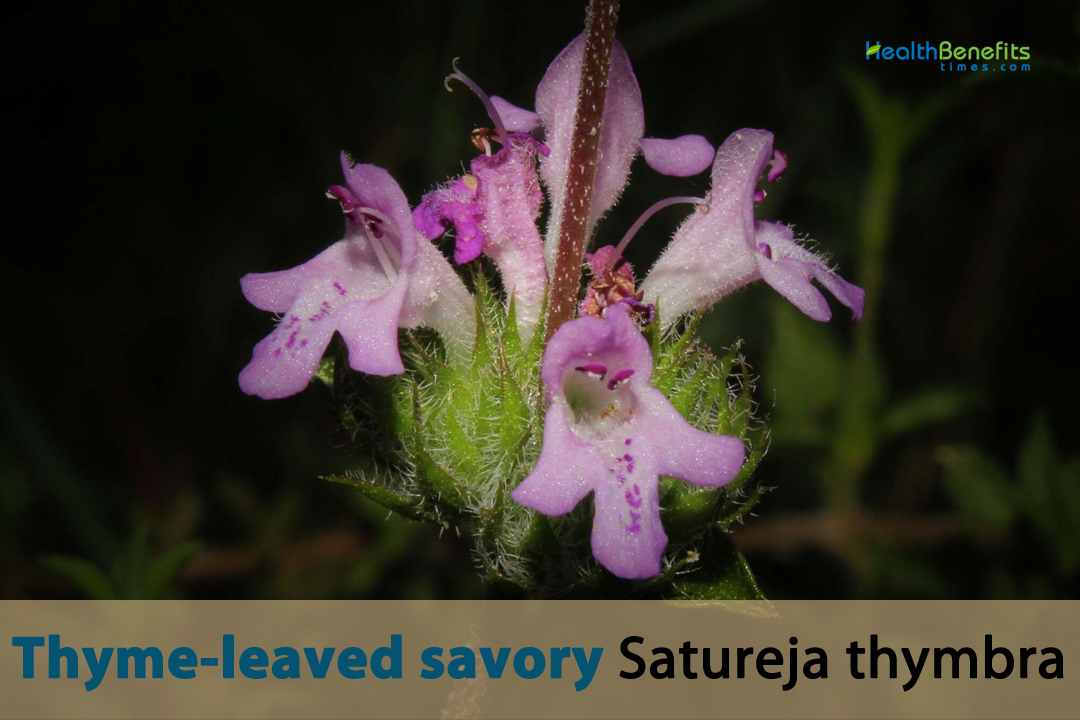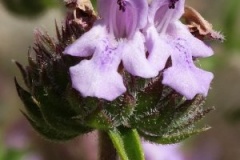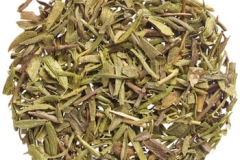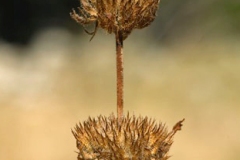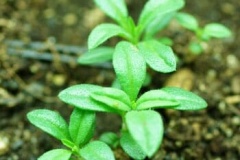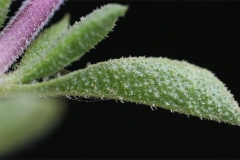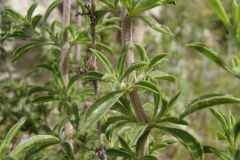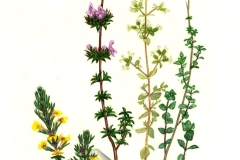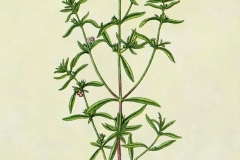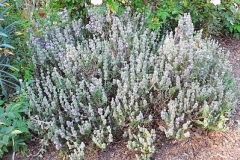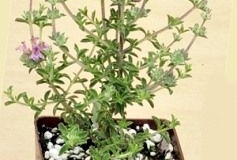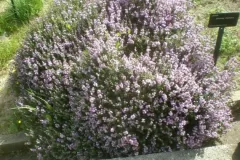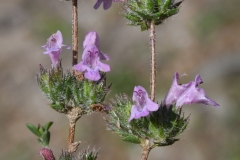The name of the genus “Satureja” comes from the Latin word “satura,” which means “fullness” or “saturation.” People think it has to do with how strong and full the herbs in this group taste. Satureja is a genus of fragrant plants in the mint family (Lamiaceae), and some of its species are savory. The name “thymbra” comes from the old Greek word “thymbrós,” which means a type of herb that tastes good or smells good. It sounds a lot like the Greek word “thymon,” which means “thyme.” This name draws attention to the fact that Thyme-leaved savory smells and tastes like thyme. People in the area gather it from the wild and use it as food, medicine, and building supplies. In the past, savory with thyme leaves was used in healing. People thought it could help with stomach problems like indigestion and bloating and used it to do so.
Thyme Leaved Savory Facts
| Thyme-leaved savory Quick Facts | |
|---|---|
| Name: | Thyme-leaved savory |
| Scientific Name: | Satureja thymbra |
| Origin | Mediterranean region, including parts of Greece, Turkey, and the Middle East |
| Colors | Typically brown or dark brown in color |
| Shapes | Schizocarp splits into four segments, each containing a single seed |
| Taste | Strong, peppery taste with earthy and woody undertones |
| Major nutrients | • Vitamin A • Vitamin C • Vitamin K • Iron • Calcium • Potassium • Dietary Fiber • Antioxidants • Essential oils |
| Health benefits | Digestive Health, Respiratory Benefits, Immune System Support, Rich in Nutrients, Heart Health, Pain Relief, Skin Health, Mental Well-Being, Weight Management, Diabetes Management, Oral Health |
| Name | Thyme-leaved savory |
|---|---|
| Scientific Name | Satureja thymbra |
| Native | Mediterranean region, including parts of Greece, Turkey, and the Middle East. |
| Common Names | Winter Savory, Mountain Savory, Savory, Creeping Savory, Creeping Winter Savory, Dwarf Savory, Garden Savory, Bushy Savory, Satureja montana, Broad-leaved Savory, Wild Thyme Savory, Creeping Mountain Savory, Rock Savory |
| Name in Other Languages | Albanian: Majdanoz malor, Majdanoz malor Arabic: السويداء الجبلية (Al-sawaida al-jebliya), الفلفل الجبلي (Al-filfil al-jabalii), السافوريا ذات أوراق الزعتر (Alsafoorya dhat awraq alza’tar), الحكمة الزعترية (Alhikmat alza’tariya), Za’atar (Liban), Za’atar Rumi, ندغ زعتري Armenian: լեռնահատ (Lernahat) Basque: Mendietako arrebieta Bosnian: Planinski mažuran Bulgarian: Горски чубрица (Gorski chubritsa), Планински чубрица (Planinski chubritsa), Планински чубрица (Planinski chubritsa), Чубрица с листа от чай (Chubritsa s lista ot chay), Чубрица с листа от чай (Chubritsa s lista ot chay) Catalan: Santoreig de muntanya Chinese: Shān péng (山蓬), Bǎilǐxiāng yè dúhuó (百里香叶独活) Croatian: Planinski mažuran, Gorski mažuran, Timijanolistni zanatlija Czech: Horský taragon Danish: Bjergsar, Bjergtimian, Timianblade krydderurt Dutch: Bergbonenkruid, Tijmbladige bonenkruid, Kanadisk Peberurt, tijmbonenkruid English: Goat oregano , Pink savory, Persian zatar, Roman zatar , Roman hyssop, Thyme-leaved savory, water savory Estonian: Mägisarapuu, Tüümianileheline estragon Finnish: Vuorisarvi , Timjanilehväinen kirveli French: Sarriette des montagnes, Sarriette de Crete, Sarriette de Sardaigne Galician: Satureia de montaña German: Bergbohnenkraut, Thymianblättrige Bohnenkraut, Zatar Parsi Georgian: Mtis tsits’aka (მთის წიწაკა) Greek: Savori (Σαβόρυ), Vounó savorí, Thymarísios thymári (Θυμαρίσιος θυμάρι), Thymbra (Θύμβρα), Tragohorto (Τραγόχορτο ), Tragorigane (Τραγορίγανη) Hebrew: Savory me’harim (סוורי מהרים), tzatrah veruddah Hindi: Pahadi pudina (पहाड़ी पुदीना) Hungarian: Hegyi szegfűszeg, Hegyi szurokfű, Kakukkfű levélű cserkeszó, Perzsa borsfű Icelandic: Fjalltimjani Irish: Seabhac na gcnoc Italian: Santoreggia montana, Santoreggia sarda Japanese: Yama saboten (山サボテン), Taimurībudosaebari (タイムリーブドセイバリ) Korean: San pyeon (산편) Latvian: Kalnu pankūka, Kalnu majorāns Lithuanian: Kalninė mažirija, Kalninė majerelė Macedonian: Gorski rigan (Горски риган) Malay: Savory gunung Montenegrin: Gorski rigan Norwegian: Fjelltimian, Timianbladet krydderurt Persian: Zareh-parvar kuhstani (زرهپرور کوهستانی) Polish: Macierzanka górska, Czaberek o liściach tymianku Portuguese: Satureja-da-montanha, Satureja de folha de tomilho Romanian: Sătrujel de munte, Cimbrișor, Cimbru de munte, Cimbru cu frunze de cimbru Russian: Gorchitsa gornaya (Горчица горная), Tim’yanolistnyy chabrets (Тимьянолистный чабрец) Scottish Gaelic: Luathad na gcnoc Serbian: Gorska rigan (Горска риган), Timjanlisni zanatilja (Тимјанлисни занатиља) Slovak: Horská škorica, Tymiánolistý záhradník Slovenian: Planinski majaron, Gorski majaron, Planinski timijan, Timijanove liste kozarec Spanish: Ajedrea de montana, sarriette à odeur de thym Swedish: Bergsarv, Timjanbladig kärvel Thai: Hom maew thiam (หอมแมวเทียม) Turkish: Dağ kekiği, Kekik yapraklı sariyet, Kara kekik, Girit sateri, halil ibrahim zahteri Ukrainian: Hirs’ka sargan (Гірська сарган), Tym’yanolysta chebrets (Тим’янолиста чебрець) Vietnamese: Rau mùi núi Welsh: Sefrwm mynyddol |
| Plant Growth Habit | Small evergreen, herbaceous, perennial shrub or sub shrub |
| Growing Climates | Sunny positions on dry rocky hills, Mediterranean woodlands and scrubland, rocky limestone gullies, alongside dirt roads, coastal plains, or in the Jordan valley, dry grasslands, scrublands, and rocky hillsides |
| Soil | Prefers well-draining soil that is moderately fertile. It can tolerate slightly alkaline to slightly acidic soil |
| Plant Size | About 6 to 12 inches (15 to 30 cm) tall and spreads to a width of 12 to 18 inches (30 to 45 cm) |
| Root | Taproot is generally thicker and longer than the lateral roots and serves as the central anchor for the plant |
| Stem | Relatively woody and branched stem which is covered with small, fine hairs, giving it a slightly fuzzy or pubescent texture |
| Bark | smooth texture. Does not have the deep furrows, ridges, or distinct patterns associated with woody bark |
| Leaf | It has narrow, lance-shaped or linear leaves that are arranged oppositely along the stem with a pointed tip and a narrower base. The leaves are typically green, although they may have a slightly grayish appearance due to fine hairs |
| Flowering season | May to June |
| Flower | Small, tubular flowers in clusters. The flowers are tubular and have a typical two-lipped structure. The upper lip is often smaller and arched, while the lower lip is larger and flat or slightly concave. They are pink to purple in color and are attractive to pollinators |
| Fruit Shape & Size | Schizocarp splits into four segments, each containing a single seed. Fruit segments are usually somewhat flattened and have a roughly triangular shape, with rounded corners |
| Fruit Color | Typically brown or dark brown in color |
| Seed | Tiny, typically measuring only a few millimeters in length. They are usually oblong or ovoid in shape |
| Flavor/Aroma | Robust and earthy flavor with hints of both thyme and pepper |
| Taste | Strong, peppery taste with earthy and woody undertones |
| Plant Parts Used | Leaves, essential oil, Aerial Parts |
| Propagation | By seeds, Stem cuttings, Division |
| Lifespan | 2 to 5 years or sometimes slightly longer |
| Season | August through September |
| Varieties |
|
| Major Nutrition |
|
| Available Forms |
|
| Health benefits |
|
Plant Description
It is a small, evergreen, herbaceous, perennial shrub or sub-shrub that gets to be about 6 to 12 inches (15 to 30 cm) tall and 12 to 18 inches (30 to 45 cm) wide. It grows in sunny places on dry, rocky hills, in Mediterranean woods and scrubland, in rocky limestone gullies, next to dirt roads, on coastal plains, or in the Jordan valley on dry grasslands, scrublands, and rocky hillsides. The plant likes dirt that drains well and isn’t too fertile. It can grow in dirt that is slightly acidic or slightly alkaline. Thyme-leaved savory is a versatile herb that is loved for its peppery, savory taste and pleasant smell. It adds a lovely Mediterranean flavor to many recipes, whether it’s fresh or dried, and has a long history of use in both cooking and traditional medicine.
In some places, savory with thyme leaves has traditional meaning. It is an important part of za’atar, a popular Middle Eastern spice mix made in Lebanon. Thyme-leaved savory, sesame seeds, sumac, and other herbs and spices are often used in za’atar. It is an important plant in many cultures around the world, especially in Mediterranean and Middle Eastern cooking. It makes a lot of different foods taste better, from cooked meats to soups and salads. The essential oils in thyme-leaved savory are thought to have possible health benefits, even though they are not used as much for medical reasons these days. It can be used in aromatherapy and plant medicines.
Appropriate growing environment for Thyme-leaved savory
Thyme-leaved savory is an herbaceous plant native to the Mediterranean region, and it thrives in environments that mimic its native habitat. Here are the key factors to consider when creating an appropriate growing environment for Thyme-leaved savory:
- Climate: The climate that thyme-leaved savory likes best is Mediterranean, with mild, wet winters and hot, dry summers. It can handle some cold, but it doesn’t do well in places with hard winters or a lot of rain.
- Sunlight: This plant needs to be in full sun to grow well. Every day, give it at least 6 to 8 hours of strong sunlight. Put it somewhere where it will get a lot of sunshine during the growing season.
- Soil: Thyme-leaved savory grows best in dirt that drains well and isn’t too fertile. It can grow in dirt with a pH level of 6.0 to 7.5, which is slightly alkaline to slightly acidic. Adding organic matter to the soil, like fertilizer, can help it drain better and grow more plants.
- Watering: Thyme-leaved savory can survive in dry conditions once it is established, but it grows best when it gets deep watered often during the growing season. When the top inch of dirt is dry, water it. Don’t water too much, because too much water can cause root rot.
- Temperature: Because this plant doesn’t like being frosty, it does best as an annual or a tender perennial in places where winters are cold. You can grow it as an annual in cooler places or bring it inside for the winter.
- Spacing: Thyme-leaved savory plants should be spaced about 12 to 18 inches apart so that they can grow and get enough air.
- Pruning: Regular trimming helps the plant keep its shape and makes it bushier. To get the stems to branch out and grow fuller, pinch back the tips of the stalks. Cut back plants after they flower to make room for new growth.
- Mulching: Putting mulch around the base of the plant can help keep the dirt moist and keep weeds from growing. You can use straw or wood chips as filler.
- Fertilization: Thyme-leaved savory doesn’t usually need a lot of fertilizer. In the spring, you can give your plants the nutrients they need by using a balanced, slow-release fertilizer.
- Pests and Diseases: Many pests and diseases can’t hurt savory with thyme leaves. However, aphids, spider mites, and white mildew can attack it. Keep an eye on the plant often and fix any problems right away.
- Harvesting: The leaves can be picked when the plant is the right size, which is usually when it’s about 6 to 8 inches tall. For cooking, pick the leaves as needed during the growth season.
Roots
Thyme-leaved savory plants usually have a taproot system, which means that the main root, called the taproot, grows up into the soil. Usually, the taproot is stronger and longer than the lateral roots. It holds the plant in place in the middle. Lateral roots grow from the taproot and spread out horizontally in different directions. It is these lateral roots that take in water and nutrients from the dirt around the plant. They can connect to make a dense network that makes it easier for the plant to get to supplies. Small root hairs cover the roots of thyme-leaved savory on a microscopic level. These structures that look like hairs make the roots’ surface area much bigger. This makes it easier for the roots to take in water and minerals like nitrogen, phosphorus, and potassium from the earth. For protection, there is a structure at the end of the main root called the root cap. As the root grows, the root cap helps it push through the soil and also feels gravity, which helps the root grow in the right direction. The depth of thyme-leaved savory’s roots can change based on the soil type and the weather. When the soil is well-drained and healthy, the roots may go quite deep. When the soil is compacted or not as fertile, the roots may stay closer to the surface.
Stem
Savory with thyme leaves has a base that is mostly woody and has many branches. The stem has lignin in it, which makes it semi-woody. As the plant grows, the stem can become stiffer. Savory with thyme leaves is a small, low-growing perennial plant. Its stems can grow straight up or spread out along the ground, getting about 20 to 40 centimeters (8 to 16 inches) tall. Thyme-leaved savory has small, fine hairs all over its stem, which gives it a slightly fuzzy or pubescent feel. The younger parts of the stem have a stronger appearance like this. There are parts of the stem called nodes and internodes. Nodes are the parts of the stem where leaves, branches, or flowers connect. Internodes are the parts of the stem that are between the nodes. Savory stems with thyme leaves can branch out from the nodes, making the plant look thick. The design of branches can change based on how the plant grows and how much it is pruned.
Bark
The stem’s top layer is called the epidermis. This layer is pretty thin and made up of cells that are very close together in thyme-leaved savory. The epidermis lines the skin and helps keep the cells below safe by stopping water loss and shielding against outside factors. The skin of thyme-leaved savory is smooth, not rough and thick like the bark on trees and shrubs. It doesn’t have the deep grooves, ridges, or clear designs that are common in woody bark. Even though it can be any color, the stem skin is usually green when the plant is young and growing. The base of the plant may get a little woody and look brownish or grayish as it grows older. The skin of the stem may have pubescence or small, fine hairs on it, especially in the younger parts of the stem. These hairs can help keep the plant from losing water through transpiration and protect it from predators. Lenticels are small raised spots that can form on the stem epidermis in some cases. Lenticels are small holes in stem tissues that let gases move between the stem’s tissues and the outside world. While they are more common on woody plants, they are not as noticeable on thyme-leaved savory.
Leaves
Thyme-leaved savory has simple leaves, which means that each leaf is made up of just one blade. Along the stem, the leaves are arranged so that they face different directions. This means that at each node, two leaves come out of the stem, facing each other. If you look at thyme-leaved savory, the leaves are usually lance-shaped or long and narrow at the base. Like the leaves of many other plants in the mint family (Lamiaceae), these leaves may look a bit long and narrow. The edges of the leaves are usually whole, which means they are smooth and don’t have any teeth or serrations on them. In turn, this makes the leaves look pretty smooth and even. Leaves usually have small, fine hairs all over them that make them feel a little fuzzy or pubescent. Having these hairs on a plant can help keep it from losing water through transpiration and keep animals away.
The leaves are usually a gray-green to green color, but they can be any color. It is common for the leaves’ top surface to be darker than their bottom surface. The midrib is the main vein in a leaf. Smaller veins branch off from it in a pinnate or reticulate design. These channels are very important for moving water, nutrients, and sugars around the leaf. The leaves can be different sizes, but most of them are small, measuring between 0.4 and 1.2 inches long and 0.2 to 0.5 inches wide. The leaves of this plant, like many others in the Lamiaceae family, have medicinal oils that give them their taste and smell. These oils give the herb its typical savory, thyme-like smell and taste. For photosynthesis to happen, leaves need to take in light energy and turn it into chemical energy in the form of sugars. The leaves are also important for reproduction because they make essential oils that add to the taste of the plant and can be used in cooking.
Flowers
Thyme-leaved savory flowers in small groups, which are called inflorescences. Most of the time, these groups can be found at the ends of the stems and in the axils of the leaves, which is the gap between the stem and the leaf. The flower structure is called a cyme, and it looks like a flat-topped or slightly rounded bunch of flowers. Individual flowers of Thyme-leaved savory are tube-shaped and have two lips, which is typical of plants in the mint family (Lamiaceae). Most of the time, the lower lip is bigger and flat or slightly curved, and the upper lip is smaller and arched. Pink to purple flowers are the most common color, but some types may have white or pale pink flowers. The color can be a little different based on the cultivar and the environment.
The base of every flower has a green, tube-like structure around it that is called the calyx. The calyx is made up of five fused sepals that cover the flower bud as it grows. The sepals may stand out more as the flower opens. Most of the time, the most bright and noticeable part of a flower is its corolla. The corolla is made up of five flowers that are fused together to make a tube-like shape with two lips. The upper lip is smaller and generally looks like a hood. The lower lip, on the other hand, is bigger and helps pollinators land. There are stamens, which are the male reproductive parts, inside the flower. Savory with thyme leaves usually has four stamens, two long and two short. The corolla tube is connected to the stamens. Pollen is made by the anthers at the tips of the flowers.
The pistil is the parts of a flower that reproduce. It has a single style with a stigma at the end. Pollen lands on the stigma during fertilization. Most of the time, the stigma has two lobes and goes to an ovary that holds the possible seeds. On the bottom lip of some flowers’ corollas, there may be nectar guides. These are usually darker lines or spots that show pollinators where the juice is, which makes them want to visit the flowers and help pollinate them. Different insects, like bees and butterflies, pollinate thyme-leaved savory. They are drawn to the colorful flowers and the juice they make.
Fruit
This is a schizocarp fruit, which is a dry fruit that splits into two or more pieces when it’s ready. Thyme-leaved savory has a schizocarp that splits into four pieces, each with one seed inside. The fruit segments are generally a bit flattened and shaped like a triangle with rounded corners. They are very small, only a few millimeters long on average. There is a difference between the green calyx of the flower and the brown or dark brown fruit pieces that are fully grown. There is one seed in each section of the schizocarp. Most of the time, these seeds are oval or ovoid and very small. They come in many colors, but most of the time they are brown to black.
Seeds
Savory seeds with thyme leaves are very small, usually only a few millimeters long. When you compare them to other plant seeds, they are pretty small. Savory seeds with thyme leaves are usually oval or long. They are a little longer than usual and have rounded tips. Seeds are usually dark to black, but they can be any color. The exact color may rely on things like how old the seeds are. There is a protective shell around each seed. It is called the seed coat or testa. The seed coat is pretty smooth and thin.
Varieties of Thyme-leaved savory
Thyme-leaved savory is an herbaceous plant with few recognized varieties or subspecies. These variations may have slightly different characteristics, including growth habits, flavor profiles, and regional adaptations. Here are a few notable varieties:
- Satureja thymbra subsp. thymbra: This is the type species. It is also called summer savory or wild Thyme-leaved savory. That’s the type of savory with thyme leaves that you’ll most likely find. It is used as a culinary plant, especially in Mediterranean food, and its leaves smell nice.
- Satureja thymbra subsp. mysica: This type of savory plant is sometimes known as “Mysean Thyme-leaved savory.” It only grows in certain parts of Greece and has slightly different taste profiles and ways of growing. Some people think it tastes stronger and more pungent than the nominate type.
- Satureja thymbra subsp. alpina: This subspecies, which is sometimes called “Alpine Thyme-leaved savory,” can grow at higher elevations and in cooler areas. It tends to grow more closely together, and the taste and chemicals that make it up can change depending on the surroundings.
- Satureja thymbra subsp. nepetoides: This type, which is known as “Nepeta-like Thyme-leaved savory,” grows in some parts of Greece and is known for its fragrant leaves. Its name comes from the fact that it looks like plants in the genus Nepeta, which includes catnips and catmint.
Health benefits of thyme-leaved savory
Thyme-leaved savory is an herb that has been used for centuries for both culinary and medicinal purposes. It offers a range of potential health benefits, although more research is needed to fully understand its effects. Here are some detailed health benefits associated with thyme-leaved savory:
1. Digestive Health
Thyme-leaved savory has traditionally been used to support digestive health. It contains compounds that can stimulate the production of digestive enzymes, aiding in the digestion of food. It may help alleviate symptoms of indigestion, bloating, and gas.
2. Antioxidant Properties
Savory with thyme leaves is full of antioxidants like flavonoids and phenolic substances. These antioxidants help the body get rid of harmful free radicals, which lowers oxidative stress and the risk of getting long-term illnesses.
3. Anti-Inflammatory Effects
Essential oils found in thyme-leaved savory, like carvacrol and thymol, have been shown to reduce inflammation. These chemicals might help lower inflammation in the body, which is a typical part of many long-term illnesses.
4. Antimicrobial Activity
The essential oils in thyme-leaved savory are also antimicrobial, which means they can kill germs, fungi, and some parasites. In the past, it was used to help fight diseases and keep things clean.
5. Respiratory Benefits
Breathing in savory steam or tea mist with thyme leaves can help with breathing problems. It might help with stuffy noses, coughs, and asthma symptoms. The antimicrobial qualities of the herb may also help it work well for treating respiratory problems.
6. Immune System Support
The antimicrobial and antioxidant qualities of savory with thyme leaves can help the immune system fight off infections and illnesses.
7. Aphrodisiac Properties
Savory with thyme leaves has been thought of as an aphrodisiac in some cultures, meaning it is thought to boost libido and sexual desire. However, there isn’t a lot of scientific evidence to back this claim.
8. Rich in Nutrients
Thyme-leaved savory has important nutrients like iron, calcium, manganese, vitamin C, and vitamin A. These nutrients are important for keeping your health in many ways.
9. Heart Health
Flavonoids and polyphenols are chemicals found in savory with thyme leaves that may be good for your heart. Because they lower inflammation and oxidative stress, these antioxidants help lower the chance of heart disease. Besides that, it might help keep blood pressure in check, which is good for heart health.
10. Antifungal Properties
The essential oils in thyme-leaved savory are antifungal, which means they can help treat fungal diseases like candidiasis. Using thyme-leaved savory on the skin or adding it to your food may help fight fungal development.
11. Pain Relief
The anti-inflammatory qualities of thyme-leaved savory can help ease the pain and discomfort of conditions like arthritis or sore muscles. It might also make menstrual cramps less painful.
12. Antispasmodic Effects
A savory herb with thyme leaves has been used to relax muscles, especially those in the digestive system. This quality might help people with irritable bowel syndrome (IBS) and other stomach problems feel better.
13. Skin Health
Putting savory oil or products with thyme leaves on the skin may be good for it. Because it kills germs and reduces inflammation, it can help treat skin irritations, acne, and cuts. But it needs to be watered down before it is put on the skin.
14. Mental Well-Being
The smell of savory with thyme leaves is thought to wake you up and may even improve your mood. The use of savory essential oil with thyme leaves in aromatherapy may help lower worry, anxiety, and mental fatigue.
15. Weight Management
Some studies show that chemicals in savory with thyme leaves may help people control their weight by making them feel full and lowering their cravings for food.
16. Diabetes Management
Thyme-leaved savory may help people who have diabetes, according to early studies. It might help make insulin work better and keep blood sugar levels in check.
17. Oral Health
Thyme-leaved savory is good for keeping your teeth healthy because it kills germs. It can help keep your mouth healthy, stop bad breath, and stop oral diseases.
18. Anti-Cancer Potential
Because it is an antioxidant and an anti-inflammatory, thyme-leaved savory has been looked at as a possible way to avoid cancer. But more study needs to be done in this area.
Culinary uses of Thyme-leaved savory
Thyme-leaved savory is a versatile herb with a flavor profile that combines the savory, peppery notes of traditional summer savory with hints of thyme. It is commonly used in culinary applications to enhance the taste of various dishes. Here are some culinary uses of thyme-leaved savory:
- Seasoning Meats: Savory with thyme leaves goes well with foods, especially chicken, pork, and lamb. It can be used to season roasts, grilled foods, stews and casseroles with meat.
- Herb Blends: It is a main part of herbes de Provence, which is a well-known French herb mix. Herbs like thyme, rosemary, oregano, and mint go well with savory leaves that have thyme on them.
- Soups and Stews: You can add savory with thyme leaves to soups, stews, and broths to make them taste savory and smell good. It tastes great in bean soups and hearty veggie stews.
- Stuffing: Savory with thyme leaves can be used to stuff chicken, game, or veggies. It gives the taste more depth and goes well with the rich ingredients in the stuffing.
- Sauces: Add savory with thyme leaves to sauces and gravies, especially ones that go with roasted foods. In some cases, it can make the sauce taste better overall.
- Marinades: Savory with thyme leaves can be used to marinate meats or veggies. It gives the items a taste that is both savory and earthy.
- Bread and Baking: For a savory twist, add fresh or dried savory thyme leaves to bread dough, buns, or focaccia. Sour cakes and scones can also be made with it.
- Vegetable Dishes: Season veggies that have been roasted or grilled with savory leaves, olive oil, and other herbs to make them taste better.
- Herb Butter: You can make a tasty herb butter by combining minced savory leaves with softened butter. This herb butter can be spread on bread or used to finish off grilled steaks and veggies.
- Pasta and Risotto: Adding savory with thyme leaves can make pasta, risotto, and grain-based meals taste even better. It goes well with both tomato-based and creamy soups.
- Egg Dishes: To add more flavor to mixed eggs, omelets, or frittatas, chop savory leaves and sprinkle them on top.
- Potato Dishes: Savory with thyme leaves can be added to mashed or roasted potatoes to make them taste more savory and green.
- Pickling: Savory with thyme leaves can be used to flavor homemade brines and pickles. It can change the taste of veggies that have been preserved.
- Cheese Pairing: Savory with thyme leaves goes well with many kinds of cheese, like goat cheese and feta. It can be added to meals with cheese or used as a garnish.
- Infused Oils and Vinegars: Soak thyme-leaved savory in oils or vinegars to make them taste better. You can put these on cooked vegetables or use them as salad dressings.
- Homemade Sausages: A lot of people use thyme-leaved savory when they make sausages. It makes both meat and veggie sausages taste better because it has a savory and fragrant flavor.
- Grilled Seafood: Salty with thyme leaves can be used to season cooked fish and shrimp. It goes well with garlic and lemon to make a sauce that is both fresh and tasty.
- Salad Dressings: To make your own salad dressing, add a pinch of dried spicy thyme leaves or finely chopped fresh leaves. It can give vinaigrettes and creamy dressings more depth and richness.
- Mushroom Dishes: The rich taste of mushrooms goes well with savory that has thyme leaves. It tastes great in mushroom risotto, pasta recipes, and mushrooms that have been sautéed.
- Pizza Toppings: On top of pizza before baking, sprinkle dried thyme leaves savory to give the pie a savory and fragrant note. It goes well with a lot of different additions and tomato-based sauces.
- Pot Roasts: Thyme-leaved savory can be added to pot roasts, braised dishes, or slow-cooked stews to make the taste stronger and more complex.
- Flavoring Oils and Butters: Add savory leaves to cooking oils or melted butter to make flavorful bases for cooking or spreading over food.
- Homemade Seasoned Salt: By combining dried savory leaves with sea salt, you can make a tasty homemade seasoned salt that can be used in many different ways.
- Béchamel Sauce: Adding savory thyme leaves to a basic béchamel sauce will make creamy meals like lasagna or gratins taste better.
- Coleslaw and Potato Salad: Fresh savory leaves with thyme leaves can be added to potato salad or coleslaw to make them more interesting and tasty.
- Herb-infused Vinegars: Sourcing savory leaves with other herbs and vinegar can make herb-infused vinegars that can be used in sauces, marinades, and pickles.
- Herb Crusts: Use savory with thyme leaves to make an herb crust for fish or meat that you roast. For a tasty covering, mix it with breadcrumbs and other herbs.
- Herb Butter for Seafood: Use savory leaves with thyme, lemon zest, and garlic to make a compound butter that you can serve with grilled or steamed fish.
- Garnish for Soups: Put fresh savory leaves with thyme leaves on top of soups and bisques right before serving to make them smell and taste great.
- Homemade Herb Blends: You can make your own herb mixes by mixing savory with thyme leaves and other herbs and spices that you like on the grill.
Different uses of Thyme-leaved savory
Thyme-leaved savory can be used in various ways beyond culinary applications. Here are different uses of thyme-leaved savory:
- Aromatherapy: Aromatherapy uses the essential oil from savory leaves with thyme because it has a scent that wakes people up and relieves stress. It can be used to calm down by adding it to diffusers or massage oils.
- Herbal Remedies: People with coughs, colds, or breathing problems use savory with thyme leaves as a natural cure. It can be used to make cough syrups, throat lozenges, and herbal lung rubs at home.
- Natural Disinfectant: Thyme-leaved savory can be used to make natural cleaning goods because it kills germs. It can be infused in vinegar or its essential oil can be used to make your own cleaning sprays.
- Insect Repellent: If you want to keep bugs away naturally, you can use the essential oil of thyme-leaved savory. To keep bugs away, mix it with a carrier oil and put it on your face.
- Floral Arrangements: The small, delicate flowers of thyme-leaved savory make it a beautiful addition to bouquets and flower arrangements, adding a touch of greens and scent.
- Crafts and Potpourri: You can use dried savory leaves and flowers with thyme in crafts, like making potpourri bags and scented candles at home.
- Gardening Companion: You can plant thyme-leaved savory with other plants in your yard to help keep pests away and bring in good bugs like bees and butterflies.
- Flavoring Beverages: In some countries, savory with thyme leaves is used to add flavor to alcoholic drinks like herbal spirits and liqueurs. It gives these drinks a unique green taste.
- Herb Wreaths: You can use savory leaves and flowers with thyme leaves to make wreaths or bouquets for your home.
- Herbal Baths: Adding dried savory leaves with thyme to herbal bath mixes will make the bath more relaxing and smell nice.
- Potpourri Bags: Put dried savory leaves with thyme and other fragrant herbs in potpourri bags and put them in drawers or closets for a natural, pleasant scent.
- Pest Control in Gardens: You can plant savory with thyme leaves near herbs and veggies in the garden to keep some garden pests away.
- Natural Hair Rinse: Adding savory leaves with thyme to water will make a natural hair rinse that can help your skin stay healthy and give your hair shine.
- Incense: Burn dried savory leaves with thyme leaves as incense to make your home smell good and clean.
- Herbal Sachets: Fill plant sachets with dried savory leaves and flowers that have thyme leaves on them. Put these sachets in your closets, drawers, or linen boxes to keep bugs away and give your space a nice smell.
- Flavoring Oils and Vinegars: To make flavored sauces, add savory leaves to olive oil or vinegar. For salad dressings, marinades, or dipping sauces, you can use these vinegars and oils that have been spiced up.
- Herbal Infusions for Bath: You can make herbal teas with savory leaves that have thyme on them and other calm herbs like lavender and chamomile. You can add these liquids to bathwater to make it more relaxing and pleasant to be in.
- Herbal Steam: Place savory leaves with thyme leaves in a bowl of hot water, either fresh or dried. Breathe in the steam. This herbal steam can help clear up stuffy noses, ease sinus pain, and make your lungs feel better.
- Herbal Potpourri Bowls: As natural potpourri, put dried savory leaves and flowers with thyme leaves in pretty bowls and place them around the house. The herb’s pleasant smell can make the setting nice.
- Natural Toothpaste and Mouthwash: Antimicrobial qualities of thyme-leaved savory make it a possible ingredient for natural toothpaste or mouthwash to help keep teeth clean.
- Herbal Sachets for Pillows: Put dried savory leaves in small fabric bags and put them inside your covers. The smell of the herb can help you relax and sleep well.
- Flavoring for Butter or Cream Cheese: Savory leaves with thyme leaves can be finely chopped and mixed into warmed butter or cream cheese to make herb-flavored spreads for crackers, bagels, or bread.
- Homemade Herbal Candles: Adding dried savory leaves and flowers with thyme leaves to homemade candles will give your rooms a unique and pleasant touch.
- Herbal Infused Honey: For a tasty sweetener, mix savory leaves with honey. You can pour this honey over sweets or mix it into herbal teas.
- Natural Insecticides: Soak thyme-leaved savory in water for a while and drain it to make a natural bug spray. Use it to keep bugs away from plants in your yard.
- Herbal Ice Cubes: Savory leaves and flowers with thyme on them should be frozen in ice cube trays with water. You can add these plant ice cubes to drinks to make them taste better.
- Homemade Herbal Soap: By adding dried savory leaves with thyme to homemade soap recipes, you can make herbal-infused soap bars that can clean and smell good.
- Scented Drawer Liners: Use paper or fabric that has thyme-leaved savory and other herbs mixed in to line your drawers. This can keep your clothes feeling good and keep bugs away.
- Herbal Pillow Sprays: Mix savory essential oil with thyme leaves and water to make a pillow spray that smells good and calms you down. Spray it on your pillows before bed to get a good night’s sleep.
Side effects of Thyme-leaved savory
Thyme-leaved savory is generally considered safe for culinary use when consumed in moderate amounts. However, like many herbs and spices, it may have some potential side effects or considerations to keep in mind:
- Allergic Reactions: Some people may be allergic or sensitive to savory with thyme leaves. If you are allergic to oregano, basil, or other herbs in the Lamiaceae family, you might also be allergic to savory with thyme leaves. Skin rashes, itching, swelling, or breathing problems are all examples of allergic responses.
- Gastrointestinal Upset: In very rare cases, eating a lot of thyme-leaved savory or its essential oil may make your stomach hurt, making you sick, or giving you diarrhea. It’s important to use this herb in small amounts.
- Interactions with Medications: Some medicines, especially ones that change how blood clots or how much sugar is in the blood, may not work well with savory with thyme leaves. If you are taking medicines or already have a health problem, you should talk to a doctor before using thyme-leaved savory in any form, whether it’s for medicine or as a supplement.
- Pregnancy and Breastfeeding: It is suggested that women who are pregnant or nursing use thyme-leaved savory in small amounts and not at all with concentrated thyme-leaved savory essential oil, since not much is known about its safety during these times.
- Essential Oil Caution: You should be careful when using thyme-leaved savory essential oil because it is very strong. It might make your skin and mucous passages itch. Before putting essential oils on your skin, you should always dilute them and do a patch test to see if your skin is sensitive.
- Photosensitivity: Some people may become more photosensitive (more sensitive to sunshine) after putting thyme-leaved savory essential oil on their skin. After putting undiluted essential oil on your face, you should stay out of the sun.
- Blood Pressure: Sea salt with thyme leaves might have a small effect on blood pressure. Talk to your doctor before taking it in large amounts or as a supplement if you have high blood pressure or are taking medicine to reduce it.
- Digestive Conditions: People usually eat savory with thyme leaves to help their stomach, but people who have gastro esophageal reflux disease (GERD) or gastric ulcers might not be able to eat it. In some cases, it might make these problems worse.
- Child Safety: When using thyme-leaved savory around young children, be careful, especially when it comes in strong forms. Keep essential oils out of their reach because they can be dangerous if they eat them.
- Pets: Pets should not be around some essential oils that come from herbs, like thyme-leaved savory. Essential oils and items that contain them should not be used near pets, and you should talk to a vet first.
References:
https://pfaf.org/user/Plant.aspx?LatinName=Satureja+thymbra
https://gd.eppo.int/taxon/STITH
https://academic-accelerator.com/encyclopedia/satureja-thymbra
https://temperate.theferns.info/plant/Satureja+thymbra


